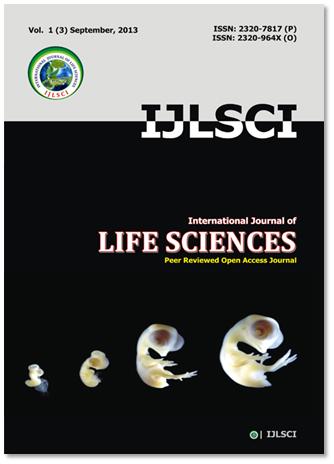Fluoride distribution in drinking water and dental fluorosis in children residing in Chandrapur District of Maharashtra
Keywords:
Chandrapur district, dental fluorosis, drinking water, fluorideAbstract
The survey was conducted to find out the fluoride (F-) distribution in drinking water and dental fluorosis in children. 5-14 years old children who were lifelong residents of Dongargaon, Pijdura and Chikni villages of Warora Tehsil of Chandrapur district, Maharashtra and who consumed drinking water from the same source of their life. The fluoride concentration was determined from different sources of water in Dongargaon, Pijdura and Chikni villages of Warora Tehsil, Chandrapur district of Maharashtra. The results revealed that about 40% of drinking water samples were found to contain more F- concentration than WHO and BIS recommended limit i.e. 1.5 mg/L and 1.2 mg/L respectively. During the survey six hundred and ninety nine children of 5-14 years (353 boys and 356 girls) were clinically examined. About 80% children from these villages show dental fluorosis. The % of dental fluorosis increased with the age and more in girls as compared to boys. Dental fluorosis is clearly indicates over-exposure to fluoride when the teeth were in developing stage. This is commonly observed across the all study sites. The dental fluorosis children shows loss of confidence and especially in the girl’s inferiority complex has been seen in the study area. A well designed epidemiological investigation can be undertaken to evaluate the risk factor associated with condition in the study area.
Downloads
References
1. APHA (2005) Standard methods for the examination of water and waste water. American Public Health Association, Water Pollution Control Federation, Washington D.C., 20th edition, 10-161.
2. Bharti P, Kubakaddi A, Rao M and Naik R (2005) Clinical Symptoms of Dental and Skeletal Fluorosis in Gadag and Bagalghat district of Karnataka. J. Hum. Ecol., 18(2):105-107.
3. BIS (2003) Indian standard drinking water specifications (First revision: incorporating Amnedement No. 1, January 1993 and Amendment No. 2, September 2003), IS10500:1991, Edition 2.2, Bureau of Indian Standards, New Delhi, India.
4. Fawell J, Bailey K, Dahi E, Fewtrell L and Magara Y (2006) Fluoride in Drinking Water. WHO drinking- water quality service. London. Human Health Effect, 29-35
5. Kamble RK and Chandekar AV (2010) Groundwater fluoride in Rajura Tehsil in Chandrapur District, Maharashtra. Indian J. Environmental Protection, 30(10): 823-831.
6. Manji F, Baelum V and Fejerskow O (1986) Dental fluorosis in an area of Kenya with 2 ppm fluoride in the drinking water. J. Dent Res., 65:659-662.
7. Medina-Solis CE, Pontigo Loyola, AP, Maupome G, Lamadrid Figueroa, H, Loyola- Rodriguez JP, Hernandez-Romano J and Marquez-Corona ML (2008) Dental fluorosis prevalence and severity using Dean’s Index based on six teeth and on 28 teeth. Clin Oral Invest., 12:197-202.
8. Meenakshi Garg, Kavita VK, Renuka and Malik A (2004) Groundwater quality in some villages of Haryana, India: focus on fluoride and fluorosis. Journal of Hazardous Material 10:685-97.
9. Nirgude A, Saiprasad GS, Naik PR and Mohanty S (2010) An Epidemological study on fluorosis in an urban slum area of Nalgonda, Andhra Pradesh, India. Indian Journal of Public Health 54 (4): 194-196.
10. Ramezani GHH, Valaei N and Eikani H (2004) Prevalence of DMFT and fluorosis in the students of Dayer city (Iran). J Indian Soc Pedo Dent., 22(2):49-53.
11. Singh M, Saini A, Saimbi CS and Bajpai AK (2011) Prevalence of Dental Fluorosis in 5-14 years old school children in rural area of the Barabanki district, Uttar Pradesh, India. Indian Journal of Dental Research, 22(3):396-399.
12. Somvanshi PR, Chaubey BS, Phadake RV and Sakharde PM (1990) Fluorosis in Maharashtra. J. Asso. Physicians of India, 38(3):217-219.
13. Sudhir KM, Prashant GM, Subba Reddy VV, Mohandas U and Chandu GN (2009) Prevalence and severity of dental fluorosis among 13-15 year old school children of an Area known for endemic fluorosis: Nalgonda district of Andhra Pradesh. India society of pendodontics and preventive dentistry, 27 (4):190-196.
14. Susheela AK (2005) An easily preventable disease through practice and intervention: New Delhi: Fluorosis Research & Rural Development Foundation. 10.
15. WHO (2004) Chemical fact sheets, Guideline for drinking water quality. Vol. 1, 3rd Edition. Geneva. 376:184-186.
Downloads
Published
How to Cite
Issue
Section
License
Copyright (c) 2013 Authors

This work is licensed under a Creative Commons Attribution-NonCommercial-NoDerivatives 4.0 International License.
Open Access This article is licensed under a Creative Commons Attribution 4.0 International License, which permits use, sharing, adaptation, distribution and reproduction in any medium or format, as long as you give appropriate credit to the original author(s) and the source, provide a link to the Creative Commons license, and indicate if changes were made. The images or other third party material in this article are included in the article’s Creative Commons license unless indicated otherwise in a credit line to the material. If the material is not included in the article’s Creative Commons license and your intended use is not permitted by statutory regulation or exceeds the permitted use, you will need to obtain permission directly from the copyright holder. To view a copy of this license, visit http://creativecommons.org/ licenses/by/4.0/











